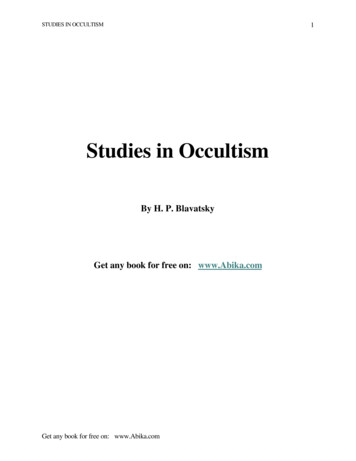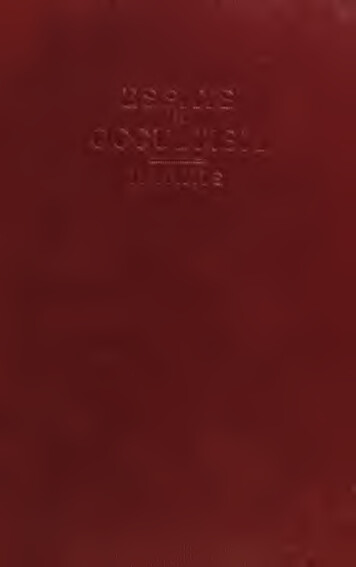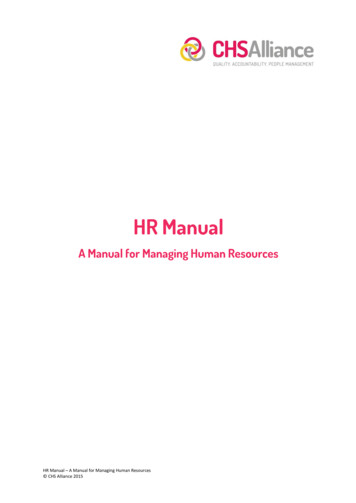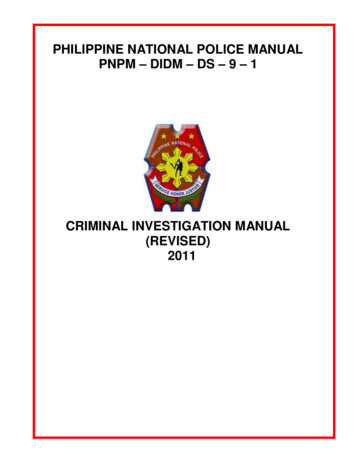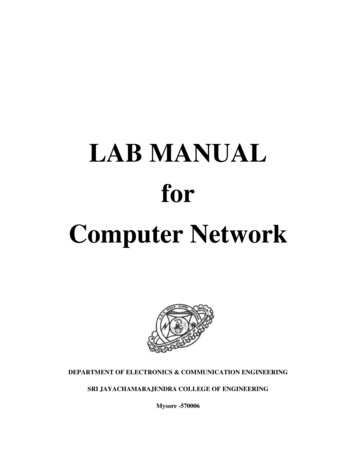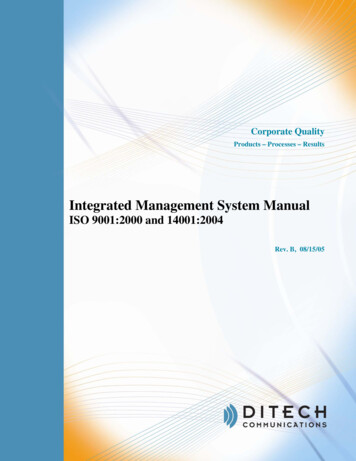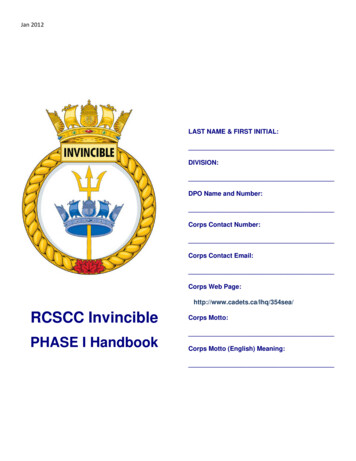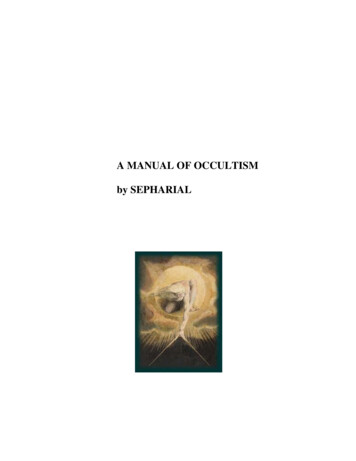
Transcription
A MANUAL OF OCCULTISMby SEPHARIAL
A Manual of Occultism, by Sepharial.A Manual of Occultism by SepharialPart IThe Occult SciencesThe Volitional Faculty - The Will and Imagination - Adeptship - Astrology - Kabalism - Talismans - Numerology Palmistry - Hypnotism, Etc., Etc.IntroductionAstrology - Section IIThe Alphabet, etc.IIThe AspectsIIIThe SignsIVThe Houses.Astrology - Section IIIMaking a HoroscopeIIForeign HoroscopesAstrology - Section IIIIPersonal AppearanceIIThe ConstitutionIIIHealthIVCharacterVAccidentsVIThe FortunesVIIThe PositionVIIIThe OccupationIXMarriageXProgenyXITravellingXIIFriends and EnemiesXIIIKinds of DeathAstrology - Section IV
A Manual of Occultism, by Sepharial.IThe Measure of TimeIIExample of DirectionsIIISecondary DirectionsIVTransits and Eclipses, etc.VMundane AstrologyVIOther MethodsPalmistryITypes of HandsIIMounts or CushionsIIIThe PhalangesIVThe LinesVNine Prinipal LinesVIIncidental MarksThaumaturgic ArtsIThe KabalaIIThe Calculatory ArtIIIOf Evil SpiritsIVMan's Spiritual FreedomVOn TalismansVINumerologyHypnotism and MesmerismPart IIThe Occult ArtsOn the Art of Divination and the use of the Automatic Faculty - The Subconcious Intelligence - Clairvoyance,Psychometry, Dreams, Etc. To Which is Appended an Essay on Alchemy.IDivinationIIThe TarotIIICartomancyIVVarious MethodsVCrystal GazingVIPreliminaries and Practice
A Manual of Occultism, by Sepharial.VIIVisions and InterpretationsVIIISome ExperiencesIXGeomancyXCasting and Judging the FigureXISymbols in the Twelve y
"Sorcery has been called Magic: but Magic is Wisdom, and there is no wisdom in Sorcery" PARACELSUS.INTRODUCTIONIT is not my intention in these pages to attempt an exposition of the deeper arcana in connection with thevarious subjects treated of; but rather to place before the lay reader a number of methods by means ofwhich he will be able to demonstrate to his own satisfaction, and that of others, that there is a deepsubstratum of truth in what is usually called "Occultism," and that the occult arts are sure and definitemeans of exploring them.The ancient Hermetic philosophers were well aware of a certain subtile correspondence or analogyexisting between the superior and inferior worlds, the world of causation and that of effects. They traceda connection between the noumenal and the phenomenal, between the mind of man and his bodilycondition, between the spiritual and the natural. They affirmed all this in a trite axiom: As above, sobelow. This philosophy extended to concrete observations, and became a science which they embodied inthe Doctrine of Correspondences. The hieroglyphic writings of the Chinese, Egyptians and Assyrians arethe outcome of this science, portions of which are current in our own thought and language. Thus whenwe speak of commerce, the merchant and the market, we are going back to traditional knowledge whichassociated the "winged messenger" of the gods with the ship in full sail; the word merx (trade) being atthe root of the name Mercury, and the symbol the hieroglyph for all that the name imports. We call theSun "he" and the Moon "she," tracing unconsciously a subtile correspondence between the day and theactive male function in nature, and between the night and the passive female function. We speak of jovialmen and infer their connection with the planet Jupiter; and all our destructive and hurtful ideas areembodied in such words as "to mar," "martial," "murder," etc., linking them to their source in the rootmarna (to strike), because the destructive element in nature is represented in our system by the planetMars.This Doctrine of Correspondences is at the root of all occult interpretation. It is our human presentationof the Universal Law which binds the Microcosm to the Macrocosm as an effect to its antecedent cause.The mystic, the poet and the creative artist are all unconscious interpreters of this universal law. Theyhave in some degree the universal sense by which their souls are rendered responsive to the pulsations ofNature’s own heartbeat. The sybil, the diviner and the seer are in even closer touch with the Great Life,while they have less conscious enjoyment of that intimacy. Others there are who reach to the heart ofthings by a clear and conscious intellection, understanding what they see, analyzing and interpreting whatthey feel. These are the Occultists, the true masters of the secret knowledge. Here it is perhaps necessaryto mark the distinction which exists between occultism and mediumism, between the voluntary consciouseffort of the trained intellect and the automatic functioning of the natural "sensitive," in their respectiverelations to the occult world.
The Occultist is one who intelligently and continuously applies himself to the understanding of thehidden forces in nature and to the laws of the interior world, to the end that he may consciously cooperate with nature and the spiritual intelligences in the production of effects of service to himself and tohis fellow-beings. This entails upon him a close study of the mystery and power of sound, number,colour, form; the psychological laws underlying all expression of faculty; the laws of sympathy andantipathy; the law of vibration; of spiritual and natural affinity; the law of periodicity, of cosmic energy,planetary action; occult correspondences, etc. To these labours he must bring a natural gift ofunderstanding, an unusual degree of patience and devotion, and a keen perception of natural facts. TheMedium, or natural sensitive, is one who holds himself in negative relations to the interior worlds, andsubmits himself to the operation of influences proceeding from things and persons, as well as to that ofdiscarnate intelligences. The medium cultivates an unusual degree of responsiveness to environment andto the emanations (atomic, magnetic or psychic) and suggestions of other persons. The phenomenadeveloped by this process of mediumism include automatism (temporary loss of control over the motornerves), as in the phenomena of involuntary speech and automatic writing; hypercesthesia, as in thefunction of clairvoyance, clairaudience, psychometry, etc.; trance, with its attendant phenomena ofunconscious cerebration, obsession, and a variety of physical effects of a supernormal character. In itshighest manifestation, following upon the "crucifying of the flesh," the subjugation of the passions, and aprocess of intense religious aspiration, mediumism is frequently followed by spiritual revelation andspontaneous prophecy. "But this sort cometh not but by fasting and prayer."The various forms of divination to which recourse is had in so-called occult circles rest largely upon theexercise of a faculty which is compounded of occultism and mediumism. They are seen to employ theautomatic faculty in conjunction with an empirical knowledge of certain occult methods of interpretation.The following pages are intended to place the lay reader in possession of some of the principal methodsof the occultists and mediums; and although nothing of a purely esoteric nature is divulged, it willnevertheless be found that everything necessary to an initial understanding and practice of the variousoccult arts is included in this work. It is within the author’s purpose to place so much information at thedisposal of the student as will effectually debar him from any excuse of ignorance concerning the psychicpowers latent in man and the verity of the occult sciences. it is within the power of everybody to beconvinced, and to convince others, while he who perseveres to the point of perfection in the exercise ofhis faculty may justly be dignified by the name of Adept. The Magi of ancient times were astrologers,diviners and prophets all, and he who would aspire to their high degree must pursue their methods andlive their life. They have committed to us the following maxims, which are still preserved in theschools—KNOW - WILL - DARE - KEEP SILENT;and to the rule of life they enjoin RIGHT THOUGHT - RIGHT FEELING
RIGHT SPEECH - RIGHT ACTIONRIGHT LIVING.
PART ITHE OCCULT SCIENCES
AMO Astrology - Section1 Chapter 1SECTION 1CHAPTER IASTROLOGYTHE astrologic art is held to be the key to all the occult sciences. Certainly it is the most ancient, and thatwhich most readily lends itself to scientific demonstration.Much that is contained in this and the following chapters is traditional knowledge but some portion of itis the result of modern discovery and experiment. Thus the nature and - significations of the signs of thezodiac and the planets, the aspects and some other parts of the groundwork of astrology, have comedown to us from times immemorial; but the methods of computing the periods, the exact tunes of events,together with some methods of interpretation, are of modem or comparatively recent Origin. Of course,all that is known of Neptune and Uranus is the result of modern discovery.The subject before us can be divided into three parts :1. The alphabet.2. The reading.3. Time measures.I will deal in this chapter withTHE ALPHABETThis includes the symbols and names of the planets and the signs, their groupings and dominions. ThePLANETS (including, for convenience of phrasing, the Sun and Moon) are nine in number. Stated in theorder of their distances from the earth they are as follows :The Moon, which returns to the same place in the zodiac in about 27 days, and to its conjunction withthe Sun in about 29 days. Every 19 years the New Moons fall in the same part of the zodiac. The Moon’scharacteristic is change or mobility.
AMO Astrology - Section1 Chapter 1Venus, which returns to the same part of the zodiac about the same date in 8 years. It is at its nearest tothe earth when in inferior conjunction with the Sun. Its characteristic is placidity or peace. It is called bythe Greeks Aphrodite.Mercury, when in inferior conjunction with the Sun, is next in distance from the earth. It returns to thesame longitude on the same date in 79 years. Its characteristic is activity.The Sun is the chronocrater of our system, and all time is measured by its apparent movements. It hasan apparent motion round the earth in hours and 4 minutes, and an annual motion through the zodiac in365 days 5 hours 48 minutes 49 seconds. The earth is nearer the sun than it used. to be, the day is shorter,and the precession of the equinoxes is greater The equinoxes pass through each sign in about 2,160 yearsThe vernal equinox is now m the constellation Pisces, and in about 700 years will be m Aquarius Thecharacteristic of the Sun is vitality.Mars returns to the same part of the zodiac about the same time at the end of 79 years Consequentlyit forms its conjunction with in the same part of the zodiac at the end of that period. Its characteristic isenergy.Jupiter returns to the same longitude about the same ‘date every 83 years It is called the GreaterFortune Its characteristic is expansionSaturn has a period of 59 years, after which it comes to the same longitude about the same date. It iscalled the Greater Infortune. Its characteristic is privation.Uranus has a synodic period of 84 years. Its characteristic is disruption.Neptune has a period of about 165 years and its characteristic is chaos.The periods of the planets according to the Chaldeans are 4 years, 10 years, 8 years,19 years,15 years,12 years, and30 years. Thus therules the life from birth to 4 years of age and is succeeded by up to 14, then to the age of 22,the Sun from 22 to 41, to whichsucceeds until 56, and is followed by , who rulesfollowed bySaturn.the life up to the age of 68, the last 30 years, up to the age of 98, being dominated byThese are the periods recited by Shakespeare in his famous passage in As You Like It, beginning "All theworld’s a stage, and all the men and women merely players." Thus theis the babe, "mewling andthe soldier,the judge "with good caponpuking in its nurse’s arms." is the scholar, the lover,
AMO Astrology - Section1 Chapter 1lined," and, the "lean and slippered pantaloon." The last stage of all is that ofparalytic senility of which condition is so aptly described by the Bard.(disruption), thePlanetary Colours.Neptune. - Mauve, lilac, heliotrope (admixtures of pale blue and scarlet).Uranus. - Grey, black and white mixed, in checks or stripes.Saturn. - Dark brown, black.Jupiter. - Violet, purple.Mars. - Scarlet, crimson.Sun. - Orange, gold.Venus. - Pale blue, turquoise.Mercury. - Indigo, dark blue.Moon. - Opal, iridescent sheens, yellow, and in watery signs (,,) sea green.Planetary Numbers.The following numbers transmitted by John Heydon in the sixteenth century have been proved correct:8,3,9, 6, 5;(negative) 4, (positive) 1."2,"7.Planetary ver;tin;silver;
AMO Astrology - Section1 Chapter 1gold.The atomic weights of the ancient metals are not presumed to have been known to the ancientastrologers, yet we find they named the planets and ascribed their dominions in the mineral world inexact accordance with the facts of modern science. The atomic weights of the various pure metals knownto them are contained in the following glyph :-This seven-pointed star is read from the ray markedtowards the left. The result is -atomic weight ksilver"200;lead"207.Read alternately in the reverse order we haveruling Sunday," Monday,
AMO Astrology - Section1 Chapter f we read from point to point so as to make a heptagram or seven-pointed star, or a star of seven angles,we have the order of the planets according to the Chaldean system:,,,,,,.Sympathies.The following glyph (see page 9) exhibits at a glance the sympathies and antipathies of the planetsThus Saturn is opposed to the Sun and Moon, Jupiter to Mercury, and Venus to Mars.This is exhibited in detail by reference to theDominionsof the planets, which are set
The Occult Sciences The Volitional Faculty - The Will and Imagination - Adeptship - Astrology - Kabalism - Talismans - Numerology - Palmistry - Hypnotism, Etc., Etc. Introduction Astrology - Section I I The Alphabet, etc. II The Aspects III The Signs IV The Houses. Astrology - Section II I Making a Horoscope II Foreign Horoscopes Astrology - Section III
